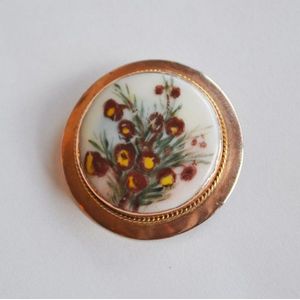Turquoise Fern Leaf Brooch with Victorian Gilding
A Victorian gilded 18ct. yellow gold and turquoise fern leaf brooch, circular form, the concave centre mounted in relief with three fern leaves each detailed with small turquoise cabochon beads. 10.4gm. Diameter 3.5 cm, a glazed portrait panel to the reverse.
You must be a subscriber, and be logged in to view price and dealer details.
Subscribe Now to view actual auction price for this item
When you subscribe, you have the option of setting the currency in which to display prices to $Au, $US, $NZ or Stg.
This item has been sold, and the description, image and price are for reference purposes only.
- Cabochon Cut in Jewellery - A cabochon cut is a type of gemstone cutting where the stone is cut and polished in a convex shape with a flat bottom and a domed top, with no facets. This type of cut is typically used for opaque or translucent stones that have natural patterns or inclusions that are best displayed in this type of cut. Examples of stones that are often cut as cabochons include turquoise, opal, and moonstone.
- Gilding - Gilding is a method of ornamentation whereby a thin sheet of gold metal is applied to items made of wood, leather, ceramics, glass and silver for decorative purposes.
For furniture including mirrors, the sheet of gold is usually applied over a coating of gesso. Gesso is a mixture of plaster of Paris and gypsum mixed with water and then applied to the carved wooden frames of mirrors and picture frames as a base for applying the gold leaf. After numerous coats of gesso have been applied, allowed to dry and then sanded a coat of "bole", a usually red coloured mixture of clay and glue is brushed on and allowed to dry, after which the gold leaf is applied. Over time parts of the gilding will rub off so the base colour can be seen. In water gilding, this was generally a blue colour, while in oil gilding, the under layer was often yellow. In Victorian times, gilders frequently used red as a pigment beneath the gold leaf.
Metal was often gilded by a process known as fire gilding. Gold mixed with mercury was applied and heated, causing the mercury to evaporate, the long-term effect of which was to kill or disable the craftsman or woman from mercury poisoning. The pursuit of beauty has claimed many victims, not the least of which were the artists who made those pieces so highly sought after today. - Victorian Period - The Victorian period of furniture and decorative arts design covers the reign of Queen Victoria from 1837 to 1901. There was not one dominant style of furniture in the Victorian period. Designers used and modified many historical styles such as Gothic, Tudor, Elizabethan, English Rococo, Neoclassical and others, although use of some styles, such as English Rococo and Gothic tended to dominate the furniture manufacture of the period.
The Victorian period was preceded by the Regency and William IV periods, and followed by the Edwardian period, named for Edward VII (1841 ? 1910) who was King of the United Kingdom and the British Dominions and Emperor of India for the brief period from 1901 until his death in 1910.
This item has been included into following indexes:
- brooches, depicting - fern themed 62
- brooches, design or type
- brooches, set with - turquoise 130
Visually similar items

A May Creeth hand painted Boronia brooch set of 9ct rose gold mount by Levinson, Perth signed and titled verso with Levinson mark diameter 2.8 cm
Sold by
in
for
You can display prices in $Au, $US, $NZ or Stg.

A retro 9ct. gold and opal ring, the oval cabochon opal doublet in a high solid rub over mount, wide tapering shank. 8gms.
Sold by
in
for
You can display prices in $Au, $US, $NZ or Stg.

A pietra dura brooch, floral panel, rolled gold mount (damaged). A/f.
Sold by
in
for
You can display prices in $Au, $US, $NZ or Stg.

A Victorian pietra dura brooch of coloured flowers, yellow gold
Sold by
in
for
You can display prices in $Au, $US, $NZ or Stg.
